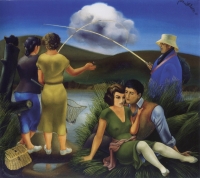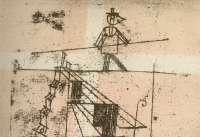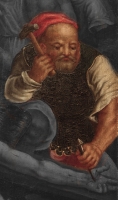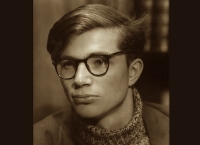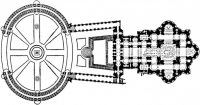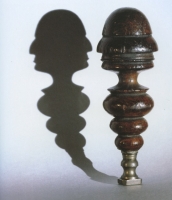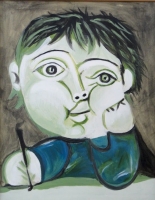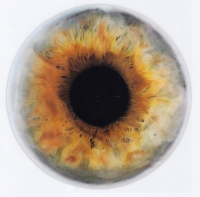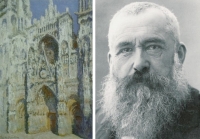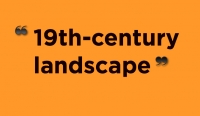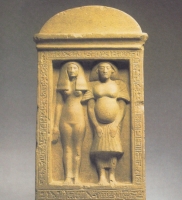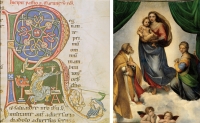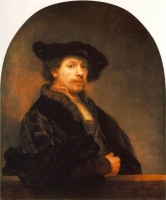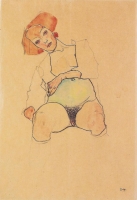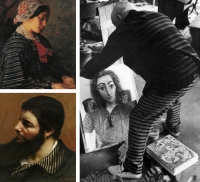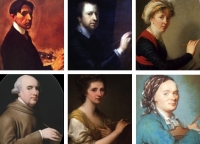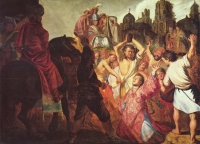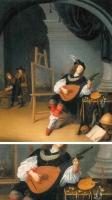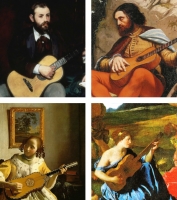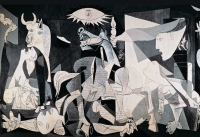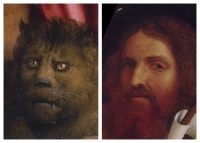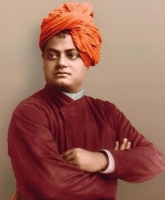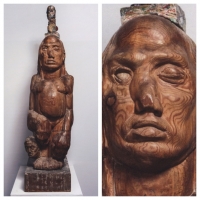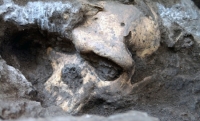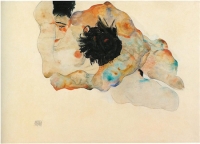06 Oct 2014 | 1 Comments
Dürer, Titian, Art and Blasphemy
For those who have trouble - I certainly did - understanding how artists like Dürer (top) and Titian (below) could have portrayed themselves as Christ, here is a poem attributed to an 11th-century spiritual master of the Greek Orthodox Church
24 Sep 2014 | 2 Comments
Reading Art: Manet, Picasso and Alfonso Ponce de Leon
My vision, like most people’s, is often cloudy which is why when the sun breaks and I gain some understanding, I get excited. You must excuse me. It may sometimes seem as if no-one before me has made similar observations. After all, all my ent
27 Aug 2014
God help me!
Failure can scare anyone, let alone artists like Paul Klee who sometimes imagine that they are performing at such a high level that the consequences of a bad showing will be free fall. Yet, like tightrope walkers, they have practiced their craft
20 Aug 2014
The Craftsman’s Christ
This is a scene by an unknown 16th-century artist, probably Flemish, at a time when artisanal effort was admired not just for the perfection of the end-product but for the artisan’s closely-guarded knowledge of materials. Wood, stone, minerals,
28 Jul 2014 | 4 Comments
Ego’s Poetic Powers
EPPH has long argued that artists mute their ego to gain access to poetic depths. Yet in the passage below Colin Wilson, the English philosopher and novelist who died last year, describes a more balanced understanding in which poets identify wit
23 Jul 2014
Key to Meaning in Architecture
Symbols, as explained here about painting and sculpture, can be concealed at many levels, some so deeply that only initiates would notice them. Who other than an architect could possibly have seen what Bernini did to St. Peter’s in Rome w
19 Jul 2014 | 1 Comments
How many features does a face need?
How much information do we need to recognize a face? Astonishingly little. Here George Washington’s can be recognized in the handle of a wooden seal (c.1810). This explains, perhaps, how artists can continuously convey their features in other
13 Jul 2014 | 4 Comments
What users are saying about EPPH
EPPH gets all sorts of readers yet of those who return, there is a definite type. How do we know? The vast majority of comments are complimentary (96%); many of you seem to respond in the same way and you are quite likely to be an artist too. Th
05 Jul 2014 | 1 Comments
Why art’s meaning repeats
There is never any new content in art [see definition below].1 Art’s meaning is true. Truth is constant. Thus, it must always be true. And it must always have been true, at least since the development of mankind. So, if art expresses fundament
25 Jun 2014 | 2 Comments
Is self-representation self-centered?
(On vacation. A re-post from last summer)
The practical and philosophical issue of whether figures in art depict the artist or the apparent character is well expressed by two different translations of the same text in a Upanishad. The p
13 May 2014
Giacometti on his Sitters’ Inner Being
So much of the poetic method in art remains a closely-held secret. Like initiates in a mystery religion, great artists have long had a common understanding that what they prize in their creative process should not be shared with the unappreciati
09 May 2014
Naming Names
Names limit. We need them as shorthand, to avoid explaining everything from scratch. But they deceive, confuse and blind. I'm talking about names in everday life and how, once used, they pigeon-hole the person, the object, the idea or whatever i
01 May 2014 | 1 Comments
An Intriguing Self-portrait, c.1345 BC
One of the earliest surviving self-portraits from antiquity is that of Bak, chief sculptor to the Egyptian pharaoh Akhenaten. It is beautifully preserved in Berlin (above) and is very intriguing given Western art history’s traditional descript
23 Apr 2014
Raphael, a Brother, and an Initial Idea
Art, according to EPPH, is esoteric, a visual primer on the Inner Tradition created by women and men every bit as spiritual as a robed monk, often more so. Indeed in the Middle Ages most artists were clerics or monks working in the scriptorium o
14 Apr 2014
Joseph Cornell gives birth to a box…
Birthing, physical birth, is one of poetry and art’s most powerful metaphors used for many centuries, perhaps ever since art first appeared. It plays on the relationship between sexual conception and mental conception while often conveying that
25 Mar 2014 | 1 Comments
Lights on Rembrandt
What does Rembrandt mean? Not his art but his name. No-one's asked that before. In a beautifully written essay Zhenya Gershman, a successful artist and EPPH follower, reveals how its meaning is reflected in all his art and even his very being. She
13 Mar 2014
Flat Noses on a Frontal Face
A year ago I used this early portrait drawing by Ingres (left) to demonstrate that Picasso's combination of faces from differing viewpoints, a hallmark of Cubism, was a technique practiced by earlier artists for a similar reason. Ingres, for ins
10 Mar 2014
Egon Schiele’s Green Belly
There is no such thing as art for art’s sake. It is a contradiction in terms. The early 19th-century art historians could see little beyond narrative so when art started to lose its connection to an apparent subject, they assumed such works we
25 Feb 2014
Picasso-as-Courbet
Many great artists I follow use a feature other than the face to identify themselves in pictures that are not self-portraits. Given that all their figures represent the artist, they need a variety of methods to hide and reveal their self-referen
23 Feb 2014
Daggers Drawn
Daggers Drawn. A new compendium of a political cartoonist’s 35 years in the business and on the cover he stands at his desk, pen drawn, facing the dictators and democrats he has followed, all with daggers drawn too. The conclusion is simple to
18 Feb 2014
Art’s Purpose
To become like God (ie, gain access to Wisdom) has long been the principal goal of all who practice inner-focused spirituality. The group includes not only monks and nuns in cloistered communities but spiritual seekers in the wider world as well
16 Feb 2014
Is Stoning Stephen Grinding Colors?
In the wider world of art history where the word "art" has not been properly defined, the search for meaning is more complex and difficult than it is here. If biologists studied different types of trees without agreeing on what a tree was, they to
12 Feb 2014
Note on Palette Sounds
My recent post on artists using stringed instruments as metaphoric palettes was restricted to guitars so I did not use this image. Perhaps I should have because while musicians may think lutes and guitars are very different, in artworks they are
09 Feb 2014
Artists and the Thumb-hole of a Guitar
I read once that Cézanne prepared his palette with as many as 18 pigments and lined them up in a series like musical scales.1 It’s an apt analogy because painters have long portrayed musicians as an allegory of their own poetic performance in
13 Jan 2014
Good Art is Not Original
There are some no-nos on EPPH to make conventional minds scream. No biography. Who cares how many women Picasso lived with? It makes no difference to the meaning of Guernica or even to images nominally depicting his loves. No historical or liter
15 Dec 2013
Lotto’s Lion and The Mystical Marriage of St. Catherine
After the recent post about how Sir Edwin Landseer became a couple of dogs (seriously), I thought it would be a good idea to keep up the pace and show how Lorenzo Lotto became a lion. Near the lower edge of one of his greatest masterpieces, The
15 Dec 2013
Your Self is My Self
You can find wisdom within all major religions (and an awful lot of nonsense too). Some of the Eastern traditions which openly concentrate on training the mind and looking inwards are particularly useful for understanding art in all media. That�
14 Dec 2013
Winking in Art
Russian artists in the early 20th century turned to the West to absorb the latest trends happening in Paris. That’s the conventional story. Yet, little known, at the same time they were also turning eastwards towards Siberia and Russia’s ori
24 Nov 2013
How a Dumb Skull Spoke
The difference between my method of looking at art and the conventional one is, in essence, quite simple: I spot-the-same while most others spot-the-difference. I notice this all the time which is why a recent advance in paleontology also caught
15 Nov 2013
Can All in Art be One?
If new visitors to EPPH wonder how landscapes, still-lifes, portraits and scenes of battle can all have a single theme, think not whether the wide variety of art can really be a single subject but whether the proposed subject, a view of the soul
The EPPH Blog features issues and commentary.

